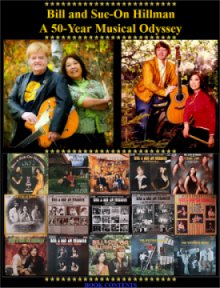China
Lady
www.hillmanweb.com/cards/sue-on/sueon1all.jpg
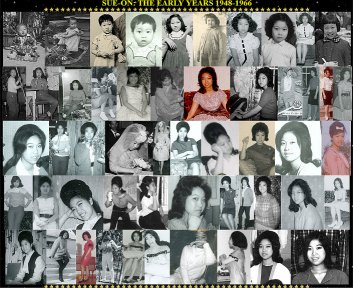 Sue-On was born in southern China,
but her family lost everything there during the Communist Revolution. At
age two she was smuggled out of China with a neighbour family and lived
with her grandmother in Hong Kong until the her mother and siblings were
able to follow.
Sue-On was born in southern China,
but her family lost everything there during the Communist Revolution. At
age two she was smuggled out of China with a neighbour family and lived
with her grandmother in Hong Kong until the her mother and siblings were
able to follow.
Eventually, at age 10, she and
her mother were allowed to join her father in a small prairie town in Canada,
where he and his father had owned restaurants for many years. She mastered
English and adapted to the new culture while working in her family's restaurant.
After we married she joined me
in performing on stage -- singing, and playing drums and keyboards. She
then completed University (BA, B.Ed) and worked as a high school teacher,
as well as spending time as a Field Supervisor for the University of Manitoba
and Brandon University -- all this while maintaining a frenetic performing
schedule and raising three kids.
When we took over the long-established
Choy family restaurant -- SOO's in Brandon -- she added the role of restaurant
manager and entrepreneur to her slate of accomplishments. We sold the restaurant
after ten years and Sue-On resumed her role as an educator. This time she
worked as an English for Academic Purposes instructor at Brandon University
-- teaching international students from all over the world. Not the least
of her achievements has been her ability to put up with my idiosyncrasies
through all these years.
Storms
Never Last
www.hillmanweb.com/cards/sue-on/sueon2all.jpg
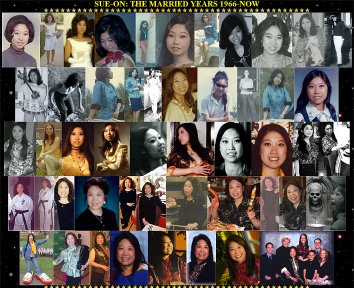 My
dad and mom owned a Marshall Wells Hardware store in nearby Newdale that
I helped work at during breaks from Brandon College. Down Main Street a
ways was the Paris Cafe -- a popular Chinese restaurant run by Soo and
Jade Choy. Their son, Kenny, and I attended Strathclair Collegiate together,
while Kenny's younger sister, Sue-On and my sister Bonnie were classmates.
My
dad and mom owned a Marshall Wells Hardware store in nearby Newdale that
I helped work at during breaks from Brandon College. Down Main Street a
ways was the Paris Cafe -- a popular Chinese restaurant run by Soo and
Jade Choy. Their son, Kenny, and I attended Strathclair Collegiate together,
while Kenny's younger sister, Sue-On and my sister Bonnie were classmates.
Sue-On and I had often exchanged small talk and she
had faithfully watched the TV shows that I was appearing on. She let my
sister know that she would love to get to know me better -- so one weekend,
while her parents were working their usual long hours in the restaurant,
she managed to leave work early and we drove to nearby Minnedosa together
for a movie: (Sue-On Remembers it as McHales Navy -- I remember
it as Jack Lemmon's Under the Yum Tree in Shoal Lake).
This was the start of a 2-year-long courtship. I even
came back to Strathclair to work as a teacher just to be near her. Our
relationship was very innocent and O so bitter sweet. We just wanted to
be together to share our dreams about life, careers, travel, and music.
. . and the future.
Eventually, we asked her parents for permission to
date. Fireworks! Fifty years ago such mixed relationships were frowned
upon in traditional Chinese culture. In the winter of '65-'66 Sue-On's
parents decided that it would be best for her to continue her schooling
in Winnipeg, where she could be more fully immersed in Chinese culture
and hopefully meet more people of her own race. Here she was enrolled in
Miles McIntyre High School, lived with relatives and paid for her keep
by working long hours during nights and weekends at the New Canton Restaurant
in Chinatown.
Undaunted by this imposed separation we kept in touch
with daily letters, weekend visits, and nightly telephone calls and weekend
trips into Winnipeg whenever I could find free time around the band's bookings.
During this time she even managed to visit relatives in Brandon one weekend
and we went to see the Guess Who and Neil Diamond at the old Brandon Arena.
She also managed to get out to Winnipeg community club dances occasionally
and we saw one of Chad Allan's last appearances with the Guess Who at the
Pink Panther. Somehow we managed to get together -- even braving the infamous
1966 blizzard.
June
3 . . . At Last. . . The Journey Begins
www.hillmanweb.com/cards/60/weddingall.jpg
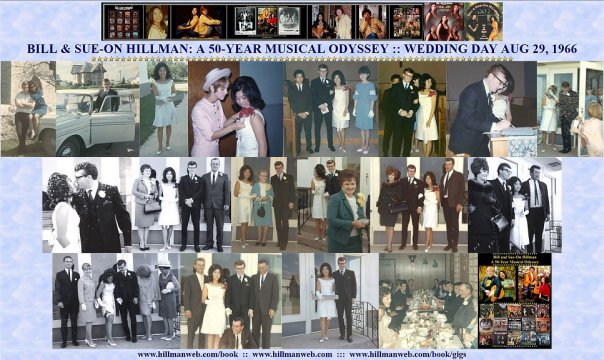 Sue-On's school year and work stint in Winnipeg was over
at the end of June 1966. But she came back home to an impossible and very
unhappy situation. On her 18th birthday -- June 3 -- she left home and
moved in with my family. She came with me to our dance and fair gigs and
we worked together through the day as painters.
Sue-On's school year and work stint in Winnipeg was over
at the end of June 1966. But she came back home to an impossible and very
unhappy situation. On her 18th birthday -- June 3 -- she left home and
moved in with my family. She came with me to our dance and fair gigs and
we worked together through the day as painters.
We saved enough money over the summer from gigs and
from painting houses and schools to pay for our wedding and honeymoon.
With only a week remaining before the beginning of my fall teaching year
we had a small wedding on August 29th, with my family, a few friends and
bandmates attending. We loaded a tent and camping supplies into our old
Rambler station wagon and headed west to Banff for our honeymoon.
We returned just in time for me to start classes. Sue-On
had taken classical piano lessons and had sung in a choir -- a fantastic
voice -- so it seemed natural that we start rehearsing an act. We wanted
nothing to keep us apart. We bought a Hohner electric piano on which I
showed her how to chord (the drums came later) and soon we had enough songs
to break in our new act in local pubs: Hamiota, Minnedosa, Shoal Lake,
Strathclair, and eventually, the big city: Brandon. We were on our way.
Television
Remotes
Sue-On's initiation into the television
production process was sort of a long distance experience. I had worked
a variety of live radio and televison shows with the Country Gentlemen
since 1962. Technology at CKX Studios gradually advanced. They eventually
were able to record TV shows on tape, utilizing a giant machine that covered
most of a wall, so they were able to time-shift our shows. Our shows could
then be seen at a later date in glorious black and white. In many ways
this was a welcome change as performing daily live shows in those days
could be quite stressful. We started to tape our daily noon show during
evenings.
During the time of Sue-On's enforced stay in Winnipeg
not even this important TV taping routine could separate the young lovers.
Nothing got in the way of our nightly calls. I taped CKX-TV shows on week
nights and the studio guys and my bandmates were very patient when she
would call in the middle of taping. I'd rush up to the control deck to
take the calls while everyone took a break on the floor. Although the band
and television crew occasionally grumbled, they were remarkably tolerant
and understanding -- one of many examples of how friends made our 2 1/2
year courtship possible.
Taping our shows had a negative side, however. The
station found that they could cut costs by showing the same shows over
and over, until we became so frustrated and embarassed by endless reruns
that we just stopped doing the daily show and concentrated on longer weekly
evening shows.
Birth
of the Western Union
www.hillmanweb.com/cards/sue-on/sueon3all.jpg
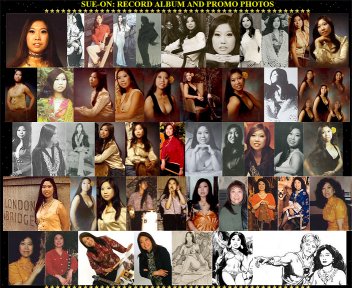 Remarkably, within two years, Sue-On was actually on that
same CKX-TV set -- and had become the featured singer with our band, which
by then I had renamed The Western Union -- a name actually inspired by
a Zane Grey novel. In the early shows Sue-On made use of a Hohner keyboard
which we had added to the band -- she made good use of her years of piano
lessons -- combined with whatever knowledge of chording by ear that I could
pass on to her.
Remarkably, within two years, Sue-On was actually on that
same CKX-TV set -- and had become the featured singer with our band, which
by then I had renamed The Western Union -- a name actually inspired by
a Zane Grey novel. In the early shows Sue-On made use of a Hohner keyboard
which we had added to the band -- she made good use of her years of piano
lessons -- combined with whatever knowledge of chording by ear that I could
pass on to her.
Later when we trimmed our numbers down to a trio again
to fit on some of the pub stages, we had more need of a backbeat to cut
through the crowd noise. By this time we had visited the old Grand Ole
Opry House in Nashville where they were finally allowing an abbreviated
stand-up drum kit. So, with this as inspiration it was back to the wholesale
catalogues from which we ordered a snare, stand, high hat and a variety
of Zildjan cymbals. We then listened to what drummers appeared to be doing
on record and... Shazam... we now had what was probably the world's only
Chinese girl, singing stand-up drummer in a country band.
The early shows were fun to do and opened up quite
a few other doors for us at the time. More and more, we were able to move
from doing pub dates and on to the larger audiences found in arenas, halls,
military bases, Winnipeg venues and summer tours. CKX started to put more
time and money into the shows so that there was a marked improvement in
the sets, production, announcing, guests, and promotion.
The
Nashville / Hong Kong / Manitoba Connection
www.hillmanweb.com/cards/roots/patsyall.jpg
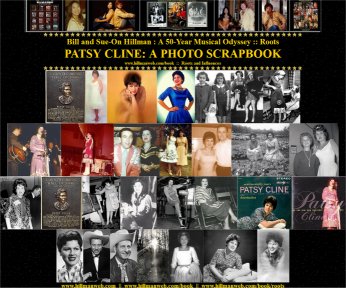 During my teen years I regularly tuned in to WSM radio
from Nashville to listen to the Saturday Night Grand Ole Opry. Our big
old Westinghouse radio usually brought this far-off station in fairly well,
but occasionally I'd have to sit out in our '49 Meteor or '60 Pontiac for
better reception from our car radio. Sometimes dial surfing would even
bring in the Louisiana Hayride where Elvis had been so popular in his early
days. It was a thrill many years later to visit and explore both Opry houses
and the Shreveport Auditorium and to try to visualize the entertainers
who had worked these stages in another time.
During my teen years I regularly tuned in to WSM radio
from Nashville to listen to the Saturday Night Grand Ole Opry. Our big
old Westinghouse radio usually brought this far-off station in fairly well,
but occasionally I'd have to sit out in our '49 Meteor or '60 Pontiac for
better reception from our car radio. Sometimes dial surfing would even
bring in the Louisiana Hayride where Elvis had been so popular in his early
days. It was a thrill many years later to visit and explore both Opry houses
and the Shreveport Auditorium and to try to visualize the entertainers
who had worked these stages in another time.
Even though I was obsessed with early rock 'n' roll,
I was just as inspired by the singers and musicians from these live country
shows. One standout singer on the Opry was Patsy Cline. One morning while
sitting in an English class at Brandon College a classmate whispered that
CKX had just reported news of a tragic plane crash that had taken Patsy's
life along with fellow Opry stars Hawkshaw Hawkins and "Cowboy" Copas.
Ironically, it was while sitting in a University of Manitoba summer school
class a year later that I learned of a similar plane crash killed Jim Reeves.
After Sue-On and I married in 1966, I introduced her
to Cline songs such as Crazy, I Fall To Pieces, and Faded
Love (country music wasn't well known in Hong Kong where Sue-On had
grown up). Sue-On even recorded her version of Sweet
Dreams for our second album. One of the first songs I had learned
for stage was Copas' Alabam, which had some neat country guitar
runs. A few decades later we heard inside stories of the plane crash when
we worked for almost a week with Hawkshaw Hawkins' widow, Jean Shepard,
at the Boggy Creek Music Festival.
Tape
That Funky Music Farmboy
We bought the Philips portable cassette
recorder when it came out and taped many of our early bar shows in the
late '60s. Until then I had used a reel-to-reel recorder for taping our
music, TV broadcasts and off-air songs. The cassette system was much smaller
and easier to use and we also taped a number of live concerts.
We later took this portable recorder with us on our
1974 summer tour playing American grandstand shows at exhibitions, State
and County Fairs, and rodeos across the North Western States. Critics of
the new system claimed that the quality would never be good enough for
recording music. We taped some of our live outdoor shows while on tour
. . . listening to the results I have to agree with the critics. . . improvements
in sound quality were soon made however, and cassettes experienced a real
boom throughout the '70s and '80s.
Ridin'
the Grain Train
1966 marked our first summer tour
for the Federal Grain Company, who over the next seven years would supply
us with a motor home and send us across Western Canada where we would perform
in parades and midway grounds on our large portable stage.
These first summer gigs were memorable because it was
the first time that Sue-On and I appeared on stage together. We performed
at summer fairs: Dauphin Fair and Rodeo, Austin Threshermen's Reunion,
Brandon Provincial Exhibition and many dance dates. Although Sue-On didn't
perform that summer, she was by my side on the parade floats and on the
stage shows -- she was starting to catch the show biz bug. At the end of
August we married and started to work on a duo singing act. She would soon
have star billing.
Western
Union and the Third Man Theme Begins
www.hillmanweb.com/cards/60/jakeall.jpg
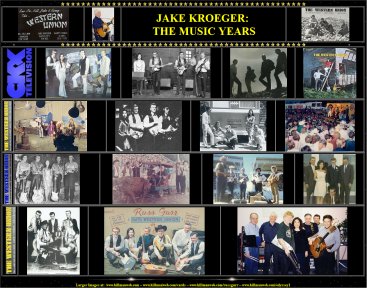 For most of our music years we have worked as a trio.
What started out as The Country Gentlemen morphed into The Western
Union after Sue-On and I married. Barry Forman needed to devote more
time to his fledgling Ford dealership and John Skinner had a farm and aging
parents who demanded more of his time, so both took a break from music.
For most of our music years we have worked as a trio.
What started out as The Country Gentlemen morphed into The Western
Union after Sue-On and I married. Barry Forman needed to devote more
time to his fledgling Ford dealership and John Skinner had a farm and aging
parents who demanded more of his time, so both took a break from music.
Jake Kroeger then became the first of a series of "Third
Men" who worked with us through the years. We developed our new Western
Union trio act by performing in beverage rooms in SW Manitoba. Jake, from
his church background, had developed fine solo and harmony vocals and played
an excellent rhythm guitar.
After a few months Barry re-joined the group. By this
time Sue-On was also playing stand-up drums, but John Skinner added a full
drum kit to some of our gigs, including some of our TV shows and our Federal
Grain summer tours with Russ Gurr. This freed Sue-On to add keyboards to
some of the songs. More importantly, it allowed her to join me at the front
of the stage for our vocals and to showcase her exciting stage presence.
Jake was with us for many a mile in the late '60s and
early '70s for our pub, dance, western tour and TV gigs -- a fine performer
and a real plus to any band. He also sang three numbers on each of our
first two albums. When he sold his farm to go full time into the plumbing
and backhoe business, it became increasingly difficult to take time off
for music. Barry then became Third Man No. 2.
Songbird
of the North
www.hillmanweb.com/cards/60/barall.jpg
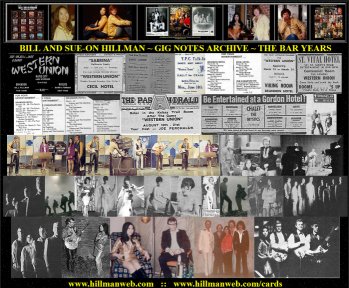 For some time before we moved into Brandon to finish our
university degrees we had been driving in to play the beverage room in
the Cecil Hotel on 10th Street. Our move to the city coincided with all
the city's hotel beverage rooms decision to hire bands... and strippers.
We have the distinction of being the first Brandon band to supply live
musical accompaniment for exotic dancers. At that time most of the girls
were imported from fairly classy clubs in Europe, and tourist towns like
Vegas -- some were quite well educated and all were entertaining.
For some time before we moved into Brandon to finish our
university degrees we had been driving in to play the beverage room in
the Cecil Hotel on 10th Street. Our move to the city coincided with all
the city's hotel beverage rooms decision to hire bands... and strippers.
We have the distinction of being the first Brandon band to supply live
musical accompaniment for exotic dancers. At that time most of the girls
were imported from fairly classy clubs in Europe, and tourist towns like
Vegas -- some were quite well educated and all were entertaining.
A popular stripper at the Cecil Hotel Beverage Room
was called Frenchie. In 1969 her act consisted of bathing in a transparent
plexiglass tub that we had to maneuver onto our stage during each of our
breaks. The splashing water was an occupational hazard. She had recently
had silicone injections into her breasts, but things had gone wrong as
one hung far below the other. She swore she was only going to perform long
enough to earn money marry her devout Mormon boyfriend. The most popular
song in her act was Neil Young's
Cinnamon Girl during which she
invited a few lucky guys up to scrub her back.
Management was impressed with Sue-On's vocals and one
night billed her on a poster alongside the stripper ad, as "The Songbird
of the North" Sue-On was so embarrassed by this that she made them take
down all the posters.
China
Cuties
Video jukeboxes
were installed in a bar we played regularly around 1967. This was an interesting
concept. Patrons would insert their quarters and choose a video to watch
on a small screen. A giant leap from the old turn-of-the-century Mutoscopes
with their cranks and flip cards, but a few years before the debut of MTV
videos. The visiting producer of the videos was impressed with Sue-On .
. . wanted to book her to appear with her Chinese Cuties troupe for a series
of Exhibition shows and the creation of song and dance videos to be filmed
in the States -- New York and Hollywood. When we showed reluctance she
said I could come along too. . . perhaps do vids for kids as "Uncle Willie"
or something. We didn't bite.
The video jukeboxes were an intriguing
phenomenon at the time but had limited distribution and weren't a financial
success. They were a short-lived experiment and we never learned the fate
of the China Cuties. . . not sure if we missed out on a once-in-a-lifetime
chance to hit the big time in American Show Biz :) A few years later,
though, Sue-On and I did a series of successful Exhibition tours in USA,
Canada and England -- we did it OUR way!
Viking
Strippers
The elaborate stage for the unique
Brandon Inn beverage room/pub/bar was built like a Viking Ship. In 1967,
our newly-formed Western Union band had the experience of introducing and
providing "bump and grind" music for the first stripper to appear in Brandon
- Desiree from Europe. This was around the time that Sue-On added a stand-up
drum kit to our stage act and it was quite an experience learning heavy
stripper beats. These early lessons stayed with her and she still has one
of the heaviest drum backbeats I know of . . . a joy to work with.
Dancer Desiree's erotic moves and peelings down to
pasties and G-string sent the crowd wild and this marked the beginning
of a long line of exotic dancers that we backed between our regular music
sets. All this was an entertaining way to work our way through college.
Our routine was the same for most days. Classes through the day. Supper.
Study and work on assignments for next day's classes. Rush to one of the
pubs where our equipment stayed set up for a week. Play our music, but
having to stay on stage during our breaks to back the strippers. Hit the
sack around 2 am and up in time for 8:30 classes next morning.
Once a week this routine was altered when we had to
find time to tape our weekly TV show at the CKX-Studios. In spite of this
strange schedule we both managed to earn our degrees -- and I was even
awarded a Silver Medal and the first B.Sc. that the newly accredited Brandon
University offered in geography.
Sweatin'
with Thumbelina and Trans
By Fall 1969 we were working our
way through college by a rotating schedule in which we appeared in every
Brandon bar for a week at a time. Almost every hotel now featured a stripper
along with the band. It seemed that each girl tried to outdo the others
with a more outrageous act.
One unusual performer was a 300 pound gal called Thumbelina.
The night before one of our shows she had overflowed the water in her bathtup
in the hotel room above the stage. The ceiling tiles above the stage were
all soggy and darkened and the water had dripped onto the stage carpeting.
She had trouble finding room on our small Beaubier Hotel stage which resulted
in our amps and instruments being knocked over.
Thumbelina was BIG, but she also had a very nice blues
voice. She did a couple numbers with us between her acts. Since she sweated
profusely, she would constantly cover herself with baby powder which got
onto our instruments and costumes. . . and "muddied" the still-wet stage
carpeting. She also "did a number" on Jake Kroeger's (our rhythm guitar
player) beautiful new white leather sport jacket when she sat on the chair
where it had been draped. It was coated with sweat and talcum powder.
Another unusual dancer was a transvestite. . . strange
seeing an exotic dancer with no waist or hips. . . and with a prominent
adam's apple.
A
"Drop Dead" Act
By 1970 the Beaubier bar started
to bring in Winnipeg bands occasionally, including one featuring Randy
Bachman's brother, Gary, on bass. But since we were the only act featuring
a Chinese girl singer/drummer and a fiddle, we were very popular.
The audience would send constant rounds of drinks and
tips. One night, after leaving a generous $20 tip for Sue-On on the stage,
an elderly customer went to the washroom and had a heart attack. We continued
to play while the ambulance drivers wheeled the poor man past us on a stretcher.
Stripper
Can't Get It Off
After Sue-On and I had both earned
our B.Ed degrees at Brandon University we returned home to Strathclair
to teach. Sue-On commuted daily to Birtle Collegiate for a few years where
she taught high school courses. We attended one of their grad ceremonies,
but there was time to kill between the supper and dance so we went to the
local pub for a beer and coke (Sue-On doesn't drink).
An "exotic dancer" provided the entertainment. When
we had worked with such dancers a few years back in Brandon most were experienced
performers brought in from other countries. The trend now was to use local,
more inexperienced talent. The girl stepped hesitatingly to the one-foot-high
little stage in a corner of the small beverage room. She was dressed in
what was obviously an ill-fitting, home-made costume and she carried a
small portable record player, which she set up at the rear of the stage.
She had trouble placing the right record on the turntable and even more
trouble placing the needle on record -- she was very nervous.
The music finally started and she went into her
"exotic dance." But she had a great deal of trouble removing her clothes
. . . the zippers stuck, and she eventually had to sit down on the edge
of stage to remove her boots which also seemed stuck. When she resumed
her awkward self-conscious dance, the jiggling stage caused the record
needle to jump. The audience made up of old-timer barroom regulars got
into the music and dance, however, and started to stomp and whoop.
One old guy seated close to the stage, obviously a
fiddle fan, played along with the music by stretching out his left arm
while fingering and bowing an imaginary fiddle. The dancer thought he was
making obscene gestures and told the management repeatedly to make him
stop. The fiddling got even wilder. The dancer finally burst into tears
and ran off the stage screaming all the way back to her room - clutching
the few clothes that she had managed to remove during her abbreviated act.
We sneaked out and returned to the school's grad dance
where the audience and proceedings were much more sedate. . . but not nearly
as much fun.

ALBUM I
PROJECT :: 1969/1970
www.hillmanweb.com/cards/60/album1all.jpg
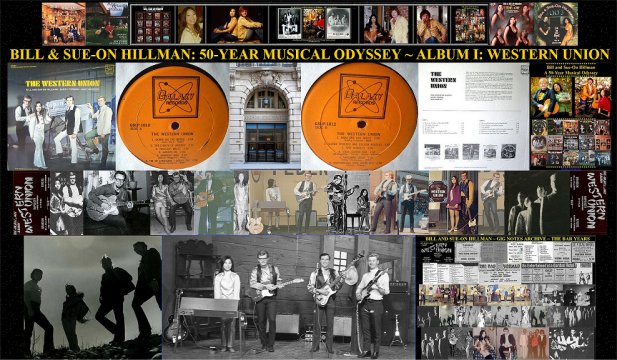
www.hillmanweb.com/cards/70/album1all.jpg
Guardians
Of The Galaxy
By late 1969 we had pretty much
touched all show biz bases: bars, concerts, tours, TV & Radio, exhibitions
media coverage, etc. The logical progression now seemed to be to get something
on record. This was a very difficult undertaking at that time as there
were no professional studios in the area. Nor was there anyone who knew
anything about getting original songs published, record production, manufacture,
distribution, promotion, etc. In our search for contacts we found that
about the only records being produced in Manitoba were ethnic (largely
Ukrainian) and gospel.
Enter Alex Moodrey, who had produced and distributed
a number of Ukainian music albums on his Winnipeg label, Galaxy Records.
The deal we made with Alex was that he would record us in his studio, pay
for the pressing and jackets, and would then have rights to our album which
he would distribute through his network of shops selling Ukrainian and
ethnic music - which included stores in Chicago, of all places. All we
would have to do would be to promise to buy a few hundred records. His
profit on our guaranteed purchase would cover all costs of production and
manufacture of 1000 albums and then anything he sold beyond that would
be to his pocket.
At the time, the deal sounded like a good initiation
into one facet of the business that was still a bit of a mystery to us.
So, we went into rehearsals. Since there were four us us in the Western
Union at that time, we decided that we would each be featured on three
songs -- this meant that Sue-On and I would have one whole side of the
proposed album to ourselves. We chose a mix of songs we were familiar with,
along with a few more obscure "classics" that we thought were long overdue
for fresh exposure. Full descriptions of the project are featured in the
Albums Section of this book.
Winnipeg
Grain Exchange Studio. . . Whaaa?!?
Being limited to three numbers each,
we all put a lot of thought into the choosing of these numbers. We had
a few rehearsals at Jake's farm near Rapid City but were a little nervous
and a whole lot excited when we finally carried our gear into the "big
time" recording studio. Also joining us on the session was Warren Hannay,
a drummer I had worked with in rock bands a few years back, but we hadn't
been able to get together for a full rehearsal with him.
All of us were more than a little bewildered at the
location of the studio: The Winnipeg Grain Exchange. Alex Moodrey's Galaxy
Recording Studio was actually some sort of all-in-one portable system which
he somehow wrangled permission to set up for the day in a room in this
Main Street old office building.
When we arrived on Saturday morning -- November 29,
1969 -- it wasn't quite what we expected: linoleum floor, bare walls, street
and corridor noise, engineer Alex sitting on a rickety old wooden chair
behind a stereo reel-to-reel recorder perched on sort of a kitchen chrome
table, and a half dozen cables leading to mics scattered around the room.
Everything would be recorded live to tape, without the benefit of baffles,
EQ, reverb, DI, overdubbing or even enough mics. A whole lotta trial and
error.
The play backs we listened to after recording each
number were not too promising, but we gave it a game try. Alex promised
us that everything would be fixed in the mix... mmmm... what mix?... and
echo would be added down east at the mastering plant. We couldn't help
but wonder just how they were going to change the sound of poor Warren's
kick drum which sounded like some sort of giant Salvation Army bass drum.
Somehow, after a long day's work, we got the twelve songs down, signed
releases and binding contracts and then five shell-shocked musicians stumbled
out onto Portage and Main -- we didn't feel much like recording stars.
FIXED
IN THE MIX! . . . MIX! . . . MIX!
The next stage of this project was
to supply Galaxy with a band photo to put on the record jacket. The people
at CKX-TV and Radio were very obliging -- we were one of the first bands
in the area to put out a record album, and since we had done shows at CKX
for many years, they readily supplied a photographer and the use of their
studio so that we could pose with a TV camera in front of one of our sets.
When the final product arrived we were happy with the
look of it but the finished mix was a shock -- delay echo on every voice
and every instrument... Whew! Like no record I'd ever heard before... or
since -- botched in post production -- but even so, it had its satisfying
moments. Almost as embarrasing was the botched back cover of the album.
The front cover was great since it featured a large colour photo that CKX-TV
had taken of the band during one of our shows in the television studio.
We were all frustrated though, when we saw the back cover that Galaxy had
come up with. Half the liner notes and credits we had supplied were replaced
by advertising of Galaxy's Ukrainian records. Warren's name had been omitted.
We learned our lesson. Sue-On and I took complete control of the next dozen
abums we recorded and we used state-of-the-art studios in Winnipeg and
during our three tours of England (London, Newcastle, Durham).
Because of our TV show and regular live performances,
the record sold pretty well -- but, foreshadowing the situation in years
to come and the success of future releases, we didn't sell any in our home
towns. Still seeking acceptance, a few years later, we even went so far
as to do hometown tribute albums and actually featured the hometown
area in a chapter for a college-level geography textbook I was commissioned
to write for Brandon University and the University of Manitoba. The book
is in its third printing but we have yet to sell one locally.
This stumbling, humbling debut experience in the recording
world only seemed to whet our appetites. We learned from our mistakes and
benefited from the experience, and a year later we were about to embark
on our second recording venture -- the first of a long line of over a dozen
independent album recordings for which we would retain complete control
and ownership.

ALBUM II:
WESTERN UNION
www.hillmanweb.com/cards/70/album2all.jpg
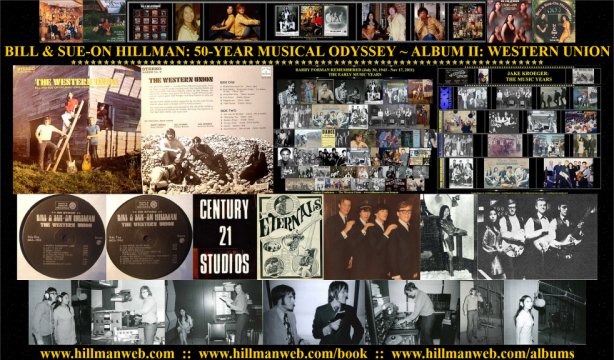
Poster
| Web |
5"
| Card
|
Thumbnail
ALBUM
TAKE 2 :: Leaving the Galaxy in Century 21
None of us
were very happy with our first record album which was done on Winnipeg's
Galaxy Records. But we had been bitten by the bug and we were sure we could
do much better if we had more control over the process. A few years earlier,
while performing at the very first Morris Manitoba Stampede Rodeo, we met
the Hildebrand and Paley brothers who were well known in Winnipeg as Ronnie
and the Eternals. Now, in 1971, about a year after our Galaxy "fiasco,"
I saw a news item that the former Eternals were opening Century 21 Studios,
a modern 8-track facility, on King Edward Street in Winnipeg.
Sue-On and I paid their new studio
a visit. It turned out that they hadn't opened yet, and we spent much of
our visit helping the guys tack acoustic tiles to the walls. We were impressed
with their enthusiasm and with the modern equipment they were installing
-- and they assured us that their studio sound, when operational, would
be far superior to that which came out of Galaxy's makeshift set-up in
the Grain Exchange. The drums were properly baffled, separated and miked.
The control room was separated from the studio area by glass and insulation.
The 8-track Ampex multi-track recorder which used one-inch-wide tape on
10 inch metal spools was pretty high tech for the time (most of the Beatles
recordings had been done on 4-track machines) and there was an impressive
array of quality mics and sound processing effects units.
WITH
A LITTLE HELP FROM OUR FRIENDS
Our next step
was to talk the other band members -- Barry and Jake -- into doing a second
album -- and assuring them that we could come up with a much better product
if we financed it and produced it ourselves in a real recording studio.
To expand our sound a bit we planned to add a few musicians to the band
line-up. Sue-On felt that she wasn't ready to play session drums yet and
preferred to concentrate full-time on her vocal tracks. The choice of a
session drummer was easy. The studio had already worked hard at developing
a good studio drum sound using Ted Paley, one of the studio owners and
drummer for the Eternals group.
We were studying geography at
Brandon University at the time, and had developed a friendship with many
of the profs. Coincidentally, one of the new lecturers in the department
was Larry Clark -- the same Larry Clark who had sat in on drums on our
old TV noon shows back in the early '60s. Larry was a well-known jazz musician
in the Brandon area, and for years had played organ nightly at the Suburban
Restaurant. Larry offered to sweeten and expand our sound by arranging
and playing piano, vibes and organ on the session. This was a real
boon as it was before synthesizers became a staple in the recording process,
and thanks to the multi-track recording process, Larry ended up playing
one to three instruments on every track which really beefed up and sweetened
our stage sound.
GOOD
VIBRATIONS:
But the Beatles Only Had Four
Tracks . . .
The luxury
of having eight recorded tracks to play with opened many doors for us.
Sue-On now could overdub harmonies on her solos and we could double track
and add more harmonies to our duets. I could now lay down acoustic rhythm
tracks as well as add more than one lead guitar line to our songs. By
this time I had customized my Telecaster by adding a Bigsby, homemade B-Bender
and re-wired pickups. I played through a DeArmond volume/tone pedal, into
an Echochord tape delay echo unit and through a Fender Twin Reverb amp.
Barry
could play bass behind his fiddle solos. We even experimented with different
percussion sounds: hand claps, tambourine, slapping guitar cases, etc.
The big problem with all this experimentation however, was that we soon
learned that we were limited by having only 8 tracks - it necessitated
careful planning and even bouncing and combining tracks. As with our first
album, each of us was responsible for doing three songs.
Our stage sound was really beefed
up and sweetened by Larry's keyboard and vibes arrangements on each number.
The sound of the vibes was especially interesting as this distinctive instrument
is used too seldom on recordings. The album sold pretty well off stage
and we may even have broken even on our investment. It proved to be an
excellent promotional vehicle and got us media coverage as well as airplay
on local radio stations and CBC. It also gave us something to feature on
our stage and TV shows and was a nice package to flog to promoters. But
more importantly, it got our creative juices flowing. Sue-On and
I started thinking about doing a solo album, and we realized that we would
get very little airplay or recognition by just recording cover tunes. I
started to write. (Album Notes Excerpt)

ALBUM III:
BILL and SUE-ON HILLMAN
www.hillmanweb.com/cards/70/album3all.jpg
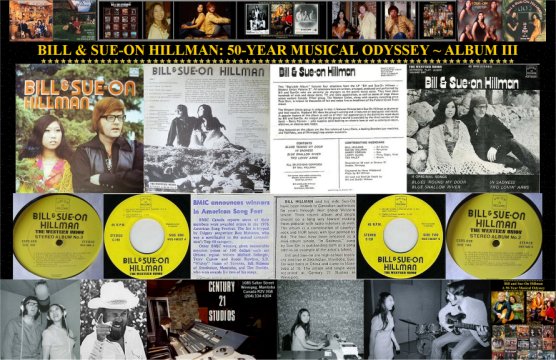
12
x 2 for Album 3: We Did It Our Way
Not long after the release of our
second album, singer/rhythm guitarist Jake Kroeger left the group and we
were again a trio. Over the next three decades a number of friends have
filled the third man spot, but we have remained a trio to this day. In
the fall of '71 we moved from Brandon and back to our Maple Grove home
where I resumed my teaching job at Strathclair Collegiate. Despite our
busy schedule of TV and dance work, preparing new curricula, remodelling
our country home, and commuting (Sue-On was finishing her Bachelor of Education
degree at Brandon University), I worked at writing original material for
the next recording session -- a session for which we had already started
setting money aside.
The first song I wrote was for my beloved grandmother,
Katie Campbell -- Nannie, who had always been so supportive of our music.
She died on Christmas day, 1971. This song seemed far too personal to share
with the world, so I moved on to more commercial themes. A metaphor used
in a Nancy Wilson song had fired my imagination: the comparison of a flowing
river to a woman... or a man... with wanderlust. It was a theme I developed
for the song, Blue
Shallow River.
Hooks,
Riffs and Beats
It was, and is, common for us to
try to put our own touch on songs we learn, rather than to just imitate
arrangements found on record. As a result we come up with intros, breaks,
rhythms that, although unusual, and sometimes 'against the grain', often
worked for us. Sometimes these hooks, beats, or riffs are strong enough
to inspire me to write whole songs around them. The next song I wrote is
an example of such a song. We had been using this choppy driving rhythm
on a number of our stage songs and one day, while fooling around with it,
I came up with a verse and chorus for what turned out to be Blues
'Round My Door.
The first two originals were basically duets, so now
I tried my hand at some ballads for Sue-On: Two
Loving Arms and the oriental flavoured
In
Sadness. Once Sue-On and I had our
first four originals sort of polished and worked out there was nothing
that could hold us back from booking studio time at the new expanded Century
21 Studios. Since we were financing the sessions and the planned
album that was to come from them, we picked out eight of our favourite
cover tunes to round out a whole album. As he had done in the previous
album, our friend Larry Clark added full keyboard and vibes arrangements
and Barry Forman played bass.
D.I.Y.
and B.M.I.: Radio-Active in the Music Scene
A few years earlier, while we were
still going to Brandon University and living with Sue-On's brother, Kenny
Choy and his wife, Rebecca, they had brought back a Pentax camera for us
from one of their trips to Hong Kong. This started me on a photography
kick that continues to this day. It seemed natural then, that we do our
own photography for the album jacket. The front cover was taken in front
of the stone fence and spruce trees at the entrance to our Maple Grove
country home where my family has lived since 1878. These trees were planted
by my grandfather sometime after the turn of the century (See John
Campbell, Pioneer). The black and white photo on the back of the album
was taken in the ruins of a stone barn built by my great grandfather in
the late 19th century. Creating our own photos involved my setting
the timer on the camera and then scrambling up a stone wall to fall into
an heroic eagle-like pose with my much more photogenic partner.
We took our photos and liner notes into a Winnipeg
graphics shop that specialized in colour separations and album covers.
The master 1/4 inch stereo tapes were sent to Toronto for mastering. While
this was going on we set plans for a 45 rpm release in motion. To get maximum
value for our money we had our four originals pressed on an Extended Play
album for which we had the local Leech Printing run off slipcover jackets.
Before we could release the original material I had to form a publishing
company, Maple Grove Music, and register the four songs with BMI.
The original "single" got some good airplay and recognition but one of
the most gratifying bits of encouragement came from the BMI
magazine, Music Scene, which gave In Sadness a rave review.
(Album Notes Excerpt)

ALBUM IV:
ON STAGE
http://www.hillmanweb.com/cards/70/album4all.jpg
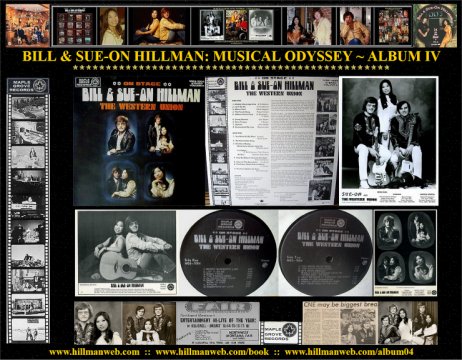
Off
Track and Behind the Scenes
Album No. 4 is mainly a compilation of all the Hillman
solos from previous efforts. After many summer tours with Russ
Gurr's Federal Grain Train show, followed by a year of exhibition shows
for Treflan Chemicals, we were invited by Bardine Productions of the USA
to audition for the NW USA Grandstand circuit. We did well, beating out
many Nashville acts and the Bardines took over management of our American
appearances. Through them we also obtained William Morris Agency representation.
We immediately told the Bardines that we planned to increase the size of
the band to come up with a bigger show, but they returned with a flurry
of personal letters insisting that the act stay as a trio. Among the reasons
they cited was the problem of obtaining work visas and clearances with
the American Musician Union, as well as the danger of bringing in a different
act than that seen by the Fair Boards who had booked us. We had to prove
to the Unions that we were offering an act that was totally unique and
different from anything American bands could offer. A singing Chinese girl
drummer and recording / television performer seemed to fit the bill and
we got our visas.
Cindy and Charlie Bardine were show business veterans
who had worked the closing days of vaudeville and who had been immersed
in all facets of show business throughout the 20th Century. They took us
under their wing and offered invaluable show biz advice. Everything from
stage entrances/exits and how to milk applause and encores, to costumes,
and to surviving on the road as a family unit . . . and how to depend on
and look to your mate for support and friendship in the crazy and often
stressful and lonely life "on the road."
The design of No. 4 set the mold for the look of most
of our future albums. We put an airbrushed black border around four studio
photos, used the logo of our newly-formed record/production company, and
displayed many candid photos in a filmstrip along the side of the back
cover liner notes and credits. The candid photos on the back cover give
some indication of what a busy year 1974 had been.
Life
In The Strip
Starting with Album Volume 4, most of our albums featured
a filmstrip which served as a sort of time capsule to capture some of our
activities and interests at that particular place in time.
Frame 1: We used the top frame of this debut
strip to unveil our new record company logo and name: Maple Grove Records.
Maple Grove has been the name of our family farm since my great-grandfather
first homesteaded it back in 1878. The logo features a Canadian maple leaf
set in a concentrically grooved disc which represents a record.
Frame 2: This frame is an oblique aerial photo
of Maple Grove. It is actually a photo I took of the framed painted-photo
taken in the mid-'50s, which is still displayed in our home. After Sue-On
and I moved into the house we worked for 25 years at making it our dream
home -- doing most of the work ourselves. We cocooned the original brick
structure with modern additions on four sides: a 50-foot solarium with
waterfall, a two-storey, cedar-lined front room with cathedral ceiling
and spiral staircase, an oak panelled den and library with adjoining bathroom
and garage, and a media room with spiral staircase leading to a master
bedroom with walk-in closets and a stacks area for storage of our magazine
and comics collections. We converted the basement into a games room and
practise recording studio.
Frame 3: Bill working at the 16-track mixing
board of the new Century 21 studio.
Frame 4: Sue-On playing drums on one of our
many CKX-TV shows. She is wearing one of the many imported East Indian
velvet, embroidered tops that we often wore on stage in the late '60s through
early '70s.
Frame 5: A shot of Sue-On and the Western Union
on an evening grandstand stage during our 1974 tour of NW USA county and
state fairs and rodeos: Sue-On drums, Bill guitar, and Barry Forman bass
and fiddle. We were the featured act on the Bardine Productions variety
grandstand circuit. Other performers included country singers Jeannie C.
Riley, Charlie Louvin and Hee-Haw's Archie Campbell as well as many international
variety/ vaudeville acts. We revelled in the backstage stories of the Opry,
escapades of early country stars, Bob Hope military tours, Ed Sullivan
performances, Marx Brothers and experiences in the last days of vaudeville,
Vegas, etc.
Frame 6: Sue-On overlooking the Century 21
board during one of our mixing sessions.
Frame 7: Bill and Sue-On in front of the television
cameras on a television set.
Frame 8: A Bill and Sue-On photo taken at Maple
Grove and first used on Album No. 3
Frame 9: Barry, Sue-On and Bill relaxing behind
the cameras during a television taping.
Frame 10: Bill, Barry and Sue-On on the Federal
Grain Train outdoor portable stage during a summer tour of Western Canada
Exhibitions. Russ Gurr is shown sitting beside Sue-On with Jake Kroeger
and Kerry Morris standing on the stage behind.
Frame 11: A symbolic roadsign pose taken outside
Sue-On's Canadian hometown, Newdale. The sign reads: Strathclair (Bill's
hometown) and Rivers (Barry's hometown). We had originally planned to use
this as a cover shot but the colours and focus didn't turn out right.
Cross-Roads
Album No. 4 was a way of collecting all of our songs
- 18 titles - from the previous albums (we did not include any songs from
album no. 1), all tied up in a nice promotional package. 1974/1975 presented
us with a major career decision: go on the road full time and put everything
into a music career . . . or stick with our secure roots in Maple Grove
and continue on with careers as high school teachers and weekend / summertime
musicians.
Note: Music continued to remain an integral part
of their lives. . . but . . . Bill retired from 30 years of high
school teaching -- in the same school -- in 1997, to move on to work as
a full-time professor at the Faculty of Education in Brandon University.
Sue-On juggled her music career with high school teaching, working for
Manitoba universities as a field supervisor for student teachers and instructor
of international students, restaurateur. . . and mom.

ALBUM V:
14 ORIGINAL SONGS
http://www.hillmanweb.com/cards/70/album5all.jpg
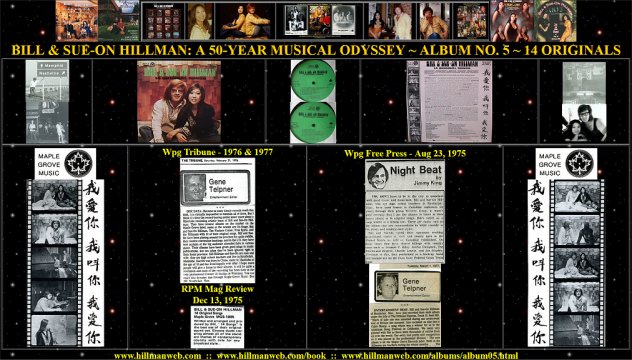
RUNAWAY SLAVES ~ PRAIRIE DANCE HALLS ~
CHINA DOLLS ~ CAJUN FIDDLES ~ WAYWARD WOMEN & RESTLESS RIVERS
~ BAR ROOM LOSERS ~ MONTANA TOURS ~ WANDERLUST ~ ORIENTAL LAMENTS ~ WISTFUL
LOVE BALLADS ~ ALLIGATOR POACHERS & MOONSHINERS ~ GOSPEL SONGS ~ MANITOBA
BOYHOOD MEMORIES
THESE RAMBLINGS FROM THE MIND OF BILL HILLMAN
HAVE INSPIRED THE SONGS WITHIN
Recording
Anecdotes
We had written four songs
for Album No. 3 which we released on a jacketed EP. The reviews from trade
papers and radio stations were encouraging enough that I kept at it. We
did four more originals for another EP which got good play on CBC radio.
In fact, my Grandmother Jane Hillman, who lived in Elrose, Saskatchewan,
was quite surprised, and I guess a little proud, to hear us on CBK Regina.
By now we had eight originals to which we soon added six more to release
as an all-original album. This album differed considerably from our previous
efforts in that we used no sidemen -- Sue-On, Barry and myself did all
the instruments, with a little help on keyboards from Kevin Pahl who was
about to replace Barry in the group.
I lived and breathed this album for many months and was involved
in all stages of its development: words and music to all songs, arrangements,
production, all guitars, half the lead vocals, back-up and harmony vocals,
photography, album design, pressing and mastering decisions, promotion,
etc. Whew!... got that outa my system. From this album on, Sue-On and I
were fully involved in all our albums -- mainly because in those early
days of Independent record production there really wasn't anyone to turn
to who could offer much in the way of professional advice, so we had to
learn as we went along.
This album marked the session debut of Sue-On on drums and as a songwriter.
She adapted a Mandarin Chinese poem to an oriental-sounding melody I had
written. Sue-On came to Canada when she was 10, and although she speaks
fluent Cantonese and Toisanese, she left her Hong Kong schooling before
she had mastered the intricacies of Chinese writing. We asked her dad,
Soo Choy, to write out the Chinese characters in the brush strokes that
appear on the back cover of the album.
An uncredited musician on this session was another young Strathclair
musician -- and future band member -- drummer Kerry Morris who dropped
by the studio. He helped Sue-On out by adding the crash cymbal to Cajun
Child. Not to be outdone, I did the percussion work on Glory Land
-- the main backbeat came from my slapping a Fender
Malibu guitar case. It's been held together by duct tape ever since.
Cover
Notes
Most of the photos on the album
cover were taken in the new music and games room in our Maple Grove basement.
We sat on a full-size snooker table -- a big antique oak effort with thick
heavy slates that Sue-On and I had disassembled and dragged down the stairs
in pieces. The background is one of our shake-covered walls while the splash
of white in front of us is actually the furry back of our Great Pyrenees
dog, Mya I. We had brought Mya back with us from our Montana tour the summer
before.
The finished albums arrived from Toronto the same day
we left for Nashville on one of our summer holiday driving marathons.
NOTE: Albums 6, 7 and 9 were recordied in London,
Newcastle and Durham studios during our three tours of the UK. Our memories
of those sessions and albums are shared in GIG NOTES CH. V: England
Tours of 1976-1979 and in the ALBUMS SECTION of our 50-YEAR ODYSSEY.
Long
Distance Drive to Memphis
1966 marked the beginning of a 10-year-run
of summer tours across western Canada and the US. After these summer
tours and before I had to return to my high school teaching duties in the
fall, we would head south on road trips. Gas was cheap and we saved
on hotel rooms by spending most nights sleeping in our station wagon or
van.
Most of our stops were show business related: Las Vegas,
Hollywood, and Tennessee. The first trip to Tennessee was one of the highlights.
We stopped at the Country Store and Casey Jones Museum in Jackson on our
way to Memphis. There wasn't much to see at Elvis' Graceland in those years,
but we came away with good photos from outside the gates as well as a few
rocks plucked off his stone fence. We drove by Sun Records which wasn't
open to the public at that time and on to explore the blues joints along
Beale Street before heading to Nashville.
Music
Row, Music City
In Nashville we walked Music Row,
visited the first Country Music Hall of Fame, and stopped at Tootsies and
other bars and music stores on Broadway. Saturday night at the Grand Ole
Opry in the Ryman Auditorium was a thrill. I remember seeing the regulars
plus the Ragin' Cajun Doug Kershaw and a young girl new to the stage whom
Loretta Lynn introduced as her little sister - Crystal Gayle.
The Southern nights were hot and the pews in this one-time
church were hard, so hawkers roamed the aisles selling fans and cushions.
After midnight we squeezed into the Ernest Tubb Record Shop on Broadway
where they pushed away the record bins so that crowds could gather around
the small stage to see the Midnight Jamboree, the second longest running
live radio show.
Back
to Tennessee
During our Nashville visits we pushed
and plugged songs and records and came close to success with numerous "almost-made-it
deals" -- a very common situation in the world of show business. The publishers
and record companies along music row were mostly set up in what had originally
been residential houses.
Our act was a bit of a curiosity and there were numerous
nibbles. Some of the record execs and artists excitedly played acetates
of their latest recording projects and some offered us songs to record.
We even visited Chet Atkins in his RCA office. He was fascinated, but didn't
think Nashville and the American South were ready for a Chinese drummer/girl
singer in a mixed marriage yet.
Later, after I had returned home to resume teaching,
our school secretary received a flurry of calls from a record company with
offices adjacent to the RCA building. They were interested in putting our
material on tapes to be sold at truck stops across America. The deal looked
promising -- they represented other artists such as Rosemary Clooney --
but somehow we just never finalized a deal. This was the first of many
opportunities that we just couldn't follow up on as long as I was dedicated
to a "day job" up in Canada. Hard decisions.
Opryland
and Southern Belles
On a later trip to Nashville we
visited the luxurious new Grand Ole Opry complex next to the Opryland theme
park . . . just down the road from Choys Restaurant where so many of the
Opry stars hung out. The Chinese kitchen staff all peeked out and came
to our table to talk to Sue-On as soon as they heard her speak in Toisanese.
As we found all across the continent and England at
that time, most of the Chinese restaurants were manned by Chinese from
Sue-On's part of Southern China. In fact, for many years Sue-On served
as a Toisonese/Cantonese interpreter for a Phoenix company translating
conversations via long distance 3-way phone calls.
During one of our visits to the South we were travelling
with our six-month-old first-born, Ja-On. At this time many American troops
were returning from Viet Nam with Asian wives. While walking through Opryland
and exploring Andrew Jackson's historic Hermitage grounds we were often
approached by women wanting to see what a child of such a mixed marriage
would look like. The usher girls at the Opry House also fawned over the
young 'un and even offered to look after him and led us to front row seats
in the Opry so we could enjoy the show. Famous Southern hospitality.
Guess
Who Wants to Jam?
www.hillmanweb.com/book/gigs/shilogw.jpg
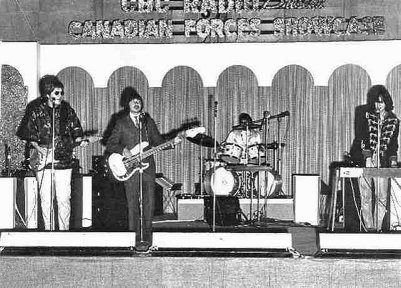 In the fall of 1968, The Guess Who from Winnipeg joined
us in CFB Shilo's Jr. Ranks Club after a CBC-TV taping produced by Dan
Wood at the base's General Strange Hall. The band was accompanied by some
of the other guests from the TV show, including singer Juliette and magician,
Bob Downey.
In the fall of 1968, The Guess Who from Winnipeg joined
us in CFB Shilo's Jr. Ranks Club after a CBC-TV taping produced by Dan
Wood at the base's General Strange Hall. The band was accompanied by some
of the other guests from the TV show, including singer Juliette and magician,
Bob Downey.
We jammed into the wee hours. Burton Cummings played
Sue-On's Hohner keyboard. Randy Bachman blew a speaker in my Fender Twin
that night. They were excited about plans to fly to NYC the next week to
record a ballad for their first release under new management and personnel
change.
They weren't too happy about doing a ballad called
"These Eyes" for their first major release. They wanted to debut with a
rocker. "These Eyes," however, went on to become a mega hit and the band
went on to super stardom.
THE
PAS FESTIVAL TRAP
Our first visit to The Pas was for
the Trappers Festival with its parades, Fur Queen judging, talent shows,
fish derby, and King Trapper contests with the log throw, tea boiling,
canoe pack, etc. We did some bar stints, afternoon shows and played for
some stompin' dances.
In the wee hours after the dances the window of our
hotel room gave us a grand view of the ongoing fights in the street below.
The bar had an international clientele made up largely of European workers
brought over to construct and maintain the Churchill Falls pulp and paper
mill.
This went over so well that the New Avenue Hotel hired
us to come back the next year to play over the 1971/1972 Christmas/New
Year week. We fulfilled this contract under great personal hardship. My
beloved grandmother Katie Campbell died Christmas day and my family delayed
Nannie's funeral to enable us to fulfill our contract at the Hotel.
On completion of contract, during which we had played
to a packed house each night, the crooked beverage room manager refused
to pay us because his feuding partner had hired us. Only time in 50 years
when we weren't paid for a gig.
Rock
'n' Roll Bagpipes - Command Performance
Throughout the '60s to '80s we regularly
played all the mess clubs at the nearby military base, CFB Shilo: Jr. Ranks,
Sgts/WO, Officers, etc. Since we were quite popular at base functions we
were hired as the first band to open the new expanded Junior Ranks Club.
Camp Commander, Colonel Matheson came in with his bagpipes
and we did a whole set of songs featuring rock and roll bagpipes. After
the show, while taking out equipment, the overactive new glass door sprang
back on me and the long Shure Vocal Master speaker columns I was carrying
shattered the glass. Interesting way to Christen the fancy new club.
Rockin'
With the German Army: G.A.T.E.S. and Panzers
In 1974 our performances at CFB
Shilo increased even more. From 1974 through 2000 Germany trained over
140,000 soldiers in Shilo under the direction of the German Army Training
Establishment Shilo (G.A.T.E.S.) and these troops proved to be a loyal
audience.
We played a number of special occasion stags where
Sue-On, as the only female among many hundreds of hard-drinking German
troops, proved to be a real attraction. She even had a number of offers
from guys who wanted to buy her stage clothes. We also played a number
of Oktoberfest shindigs and even weddings. Many of the troops married local
girls -- possibly with thoughts of returning to Canada after their military
stints which many of them did.
The visiting Germans had a great interest in Canadian
history and quite a number of Indian girls were taken back to Germany.
Furs and pelts were also much in demand. We found the German customs to
be very fascinating and especially popular was the German food and beer
that was flown over in great quantities for their parties.
Tommy
Hunter TV Show Cast: Our Turn to Entertain
We were one of the last acts to
play the huge stately Prince Edward Hotel Ballroom before this grand old
hotel was demolished. The two most memorable gigs involved us being hired
by a local service club to perform late-night, after-show celebration and
unwind shows and dances for famous performers who had played the arena
earlier in the evening.
The first was for the entire cast of the Tommy Hunter
TV Show -- his supporting acts from his TV show (Debbie Lori Kaye, Rhythm
Pals, etc.) and the backup musicians and road crew. Years later we also
had a great time backing two of the show's regulars, Al Cherney and Johnny
Thorson, for many arena shows.
Entertaining
the Johnny Cash Show: Johnny's On the Wagon
www.hillmanweb.com/cards/roots/cashall.jpg
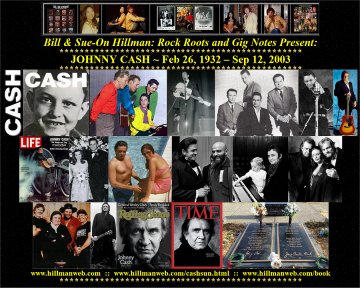 Our
first Prince Eddie gig went so well that we were hired again when the Johnny
Cash Show came to town. It was a thrill to meet and play for the Carter
Family, Carl Perkins, The Statler Brothers, etc.
Our
first Prince Eddie gig went so well that we were hired again when the Johnny
Cash Show came to town. It was a thrill to meet and play for the Carter
Family, Carl Perkins, The Statler Brothers, etc.
I was looking forward to another meeting with Luther
Perkins, who had given me one of my first guitar lessons about 10 years
before. Luther, along with bassist, Marshall Grant, had been with Johnny
from the start back in Memphis and gave the Tennessee Two (later Tennessee
Three when drummer W. S. "Fluke" Holland was added) their distinctive "boom-chicka-boom"
sound. Sadly, Luther had died in a house fire a few months before and had
been replaced by young Bob Wootton, who did a quite amazing effort at imitating
Luther's palm-muting guitar style. He knew the intros, breaks and extros
to all of John R's hits.
The event was even more memorable because Johnny and
June had been recently married back in March. Johnny had actually proposed
to her onstage at a show in London, Ontario. We performed for the crowd
made up of the Johnny Cash show performers and specially invited Brandonites.
Everyone waited expectantly for the two stars to appear. Johnny finally
appeared with June reluctantly in tow. Johnny made a few thank you remarks
and then June dragged him back toward their room. With June's help he was
on the wagon after his many years of self-destructive road life -- she
led him from temptation that night. Sue-On and I quickly took our break
and rushed out to the hallway where we met up with the famous duo and spent
some time making small talk with them.
In more recent times we've seen Bob Wootton and his
new Tennessee Three band a number of times. Bob does a fine job on Johnny's
vocals and is accompanied by his wife and daughters. The first time his
group appeared in Brandon there was the added plus of seeing the legendary
WS "Fluke" Holland on drums. Holland had gotten his start with Carl Perkins
playing "Blue Suede Shoes," etc., was in on the famous Million Dollar Quartet
session at Memphis' Sun Studio, and had been part of Johnny's Tennessee
Three band until the singer's death. They were great guys to chat with
and our Website features the photos of the three of us that buddy Bill
Stadnyk had taken one night.
Folk
Harmony Roots
Our show numbers have always been
divided into three groups: individual solos and duets. Sue-On has a remarkable
ear for harmony so our repertoire has always included songs by The Everly
Brothers, Simon and Garfunkel, and especially Ian and Sylvia.
Sue-On on drums has always provided our sound with
a wickedly heavy backbeat so many of the "folkish" songs have taken on
a country rock feel. Even our first albums show evidence of this with our
versions of
Silver Threads and Golden Needles and Ian and Sylvia's
You
Were On My Mind. It was quite a thrill seeing their show at Westman
Auditorium and meeting with them after the show in Brandon's Suburban Night
Club. Years later we were fortunate to see both performers when they worked
as solo performers.
The amazing Everly Brothers whose harmonies have had
such a major influence on pop music were a very early influence. Meeting
and opening for them in 1965 was a great thrill as I described in chapter
10 of these gig notes. We've covered many of their songs over the years,
including our recorded version of Let It Be Me.
Three
Lashes Across the Eyes
While teaching at Birtle Collegiate,
Sue-On did the make-up for the young performers in their school drama productions.
She even formed and coached a make-up team for the Strathclair Drama Club's
annual productions. This was not surprising since she had done her own
stage make-up for many years.
Since we had played a wide variety of gigs she was
quite adept at applying many different styles ranging from a light touch
for small venues, to heavier emphasis for television, to very heavy stage
make-up for huge grandstand shows. From a long distance and under bright
stage lights the faces and features of performers become washed out unless
heavy make-up is applyed. For some of the big gigs she even wore three
pairs of eyelashes.
Channeling
Stompin' Tom
One of Sue-On's extra-curricular
duties as a high school teacher at Birtle Collegiate was to direct the
Glee Club. Her show biz experience and knowledge of harmony and rhythm
served her well in this role of musical director. During rehearsals for
a '50s-style music concert she often stomped out the beats to emphasize
the rhythm of the songs.
On one particularly animated session, one of her colleagues
sneaked in to the stage area and placed a board under her stomping foot,
a la Stomping Tom Connors. The prank sent Sue-On and the whole group into
paroxysms of laughter, which brought about the end of that day's reheasals.
She
Can Sing. . . But Can She Drive?
Noticing the popularity of our TV
shows and Sue-On's natural on-camera presence, a local car dealership asked
her to do a television commercial extolling the advanced features of their
latest sporty compact model. Around this time Japanese car companies were
making many inroads into the Canadian auto market. The car company thought
that hiring an Asian to promote their North American product would provide
a neat way of minimizing the impact of the Japanese invasion.
The first part of the car commercial featured Sue-On
in the studio going through the usual moves of opening doors and pointing
out features. The commercial then cut to an exterior shot taken on the
Grand Valley road. Now, Sue-On was driving the vehicle and leading a whole
convoy of similar models. She led this stream of shiny new cars around
the highway curves while waving to the cameras. I couldn't help thinking
that if she had suddenly hit the brakes the resulting multi-car pile-up
would have made for a spectacular television event : )
Uncle
Smokey
At one time Brandon jazz musicians
met, visited and jammed in a house they maintained for that purpose. One
of the musicians we met there played an important part in our early years.
Larry Clark had a regular job playing organ at the Suburban supper club
on Victoria Avenue. Somehow, when Barry and I were looking for musicians
for the first year of our CKX-TV Noon shows, Larry picked up sticks and
became our drummer.
Some time later when he had moved on to become a lecturer
at Brandon University we had occasion to jam a bit and came to realize
what a remarkable musician he was on keyboards and vibes. When it came
time to do our second and third albums we asked Larry to join us. He played
three instruments: Yamaha organ, piano and vibes -- and wrote arrangements,
which multi-track recording made possible to integrate into our basic guitar,
bass and drums sound.
A few years later, Larry changed professions and moved
to the wilds of Eastern Manitoba, where he became a forest ranger. It was
during this time that he wrote and recorded solo albums of Campfire Songs
by Uncle Smokey. In the '90s Sue-On, the kids and I had some great visits
with Larry and his wife Linda in their cabin and the kids had a wonderful
time playing in the woods, streams . . . and bomb shelter in the backyard
-- a leftover from the Red scare days of the '50s.
The most exciting attraction, though, was the giant
forest lookout tower where Larry put in long hours scanning the horizon
for distant forest fires. Even in this lofty perch, music was never far
away as he had a guitar and small keyboard in ready reach. A great place
to get away from it all . . . and write songs. I couldn't resist making
an inspection and surprised him one day when I, accompanied with our young
son, Ja-On, climbed to the top of this towering tower to check out the
360 view of the forest, to better see him at work . . . and to hear Uncle
Smokey's latest ditties.
A
Touch of China
Stories Carved in Antique Camphor and Teak
Wood
www.hillmanweb.com/cards/early/home1all.jpg
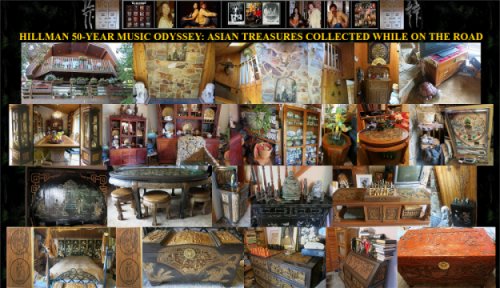 I've always had an appreciation for all things Chinese
and Asian . . . heck, even my wife was made in China. I guess it started
with my dad's tales of Hong Kong, which he shared when he returned from
serving on the RCN ship, HMCS Prince Robert in WWII. He brought back many
souvenirs: carved ornaments, vases, field glasses, swords, silks, photos,
etc. Of special interest were the photos of the Chinese musical entertainment
troupes that entertained the ship's crew while docked at Kowloon.
I've always had an appreciation for all things Chinese
and Asian . . . heck, even my wife was made in China. I guess it started
with my dad's tales of Hong Kong, which he shared when he returned from
serving on the RCN ship, HMCS Prince Robert in WWII. He brought back many
souvenirs: carved ornaments, vases, field glasses, swords, silks, photos,
etc. Of special interest were the photos of the Chinese musical entertainment
troupes that entertained the ship's crew while docked at Kowloon.
Chinese restaurants with their exotic food and culture
were a mainstay on the prairies where I was raised and some of my classmates
were Chinese. In fact, Sue-On's brother, Kenny, and I became friends and
classmates after he immigrated from Hong Kong.
After Sue-On and I were married she shared much of
her Asian heritage and prepared amazing exotic dishes. We often ate Chinese
on the road and we even introduced Asian touches into our costumes and
music. Our music has taken us across North America, England, Europe and
the Far East. It is not surprising then, that we amassed quite a collection
of Asian music, art, ornaments, food and furniture from these travels.
Our homes are filled with a fascinating mix of books,
videos, plants, music and instruments against a backdrop of influences
from our Scottish/English and Chinese cultures -- much of which we have
brought home from our music tours. We are especially proud of our collection
of unusual musical instruments and carved wooden furniture pieces which
we have found in Asia. We've shared photos of these hand-carved treasures
on our main Website and in our photo archive.
MY
PRINCESS by Bill Hillman
www.hillmanweb.com/cards/sue-on/sueon4all.jpg
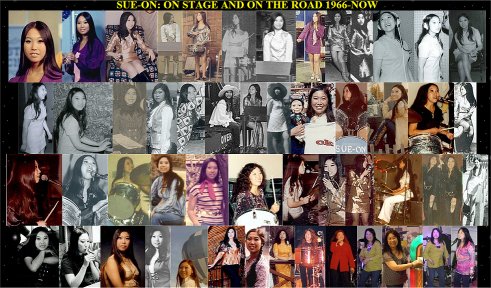 She was two years old when her mother
pressed her into the arms of a fleeing neighbour woman who had wrangled
a pass to Hong Kong. With her mother detained by the newly-empowered Communist
Government in Canton, and her father in the far-away land of the gold mountain,
the world suddenly became a terrifying and lonely place to this toddler.
Even after her mother finally managed to join her in Hong Kong, it would
be eight more confusing years until the family could be reunited in Canada.
She was two years old when her mother
pressed her into the arms of a fleeing neighbour woman who had wrangled
a pass to Hong Kong. With her mother detained by the newly-empowered Communist
Government in Canton, and her father in the far-away land of the gold mountain,
the world suddenly became a terrifying and lonely place to this toddler.
Even after her mother finally managed to join her in Hong Kong, it would
be eight more confusing years until the family could be reunited in Canada.
It was an alien, hostile land
which greeted the little girl and her mother after the days-long airplane
journey: huge cars, bewildering mobs of "go bays" who all looked and sounded
alike -- greasy, smelly foods -- miles of endless highways stretching across
a flat and barren countryside of ice and snow... a cold and a wind which
hurt her face, her ears, her hands and which, for some reason, tied her
stomach into knots... and an endless trip across this land to another new
home -- a house and restaurant in a place with an unpronounceable name:
Newdale.
She had ranked above all the
other girls in the Catholic School back in her warm Hong Kong, but here
she found herself pushed in with little six-year-old girls... and boys
-- everyone in the school stared, snickered, and talked that strange babble
behind her back -- and no one could understand anything she tried to say
or do.
For the next seven years every
waking moment outside of school hours would be spent working in the restaurant
-- The Paris Cafe (her grandfather had named it many years before). All
the drama of her little world -- family life, social life, homework, relaxation
-- and her indoctrination into this "O so foreign" rural farm community
-- would play against a backdrop of high wooden booths, counters and stools,
magazine and grocery displays, and a "Specializing in Chinese and Canadian
Dishes" kitchen. The work was hard and long -- there was endless preparation
of food, shelves to be stocked, orders to be served from 7 am to 11 PM,
and a daily supply of water to be dragged from the town well.
She fell in love at 15 with a
local musician and they married when she turned 18. She and her husband
attended university and performed nightly in Brandon nightspots for enough
years to garner five university degrees and to become high school teachers
and university profs. She travelled and performed across two continents,
bore three glorious children, and excelled in cooking, gardening, crafts,
karate, music, motherhood, and as a person. To this list of accomplishments
she added the role of restaurateur, as she and her husband owned and managed
SOO’S – a 265-seat restaurant in downtown Brandon for 10 years. Following
the sale of the restaurant in 2002 she took a teaching position at Brandon
University.
This little-smuggled-waif-turned-beautiful-woman
is the most amazing person and musician I have ever met. She is an inspiration
and a source of wonder to all who have been touched by her aura. . . .
I have been touched. ... I married her...

![]()













 Our
first Prince Eddie gig went so well that we were hired again when the Johnny
Cash Show came to town. It was a thrill to meet and play for the Carter
Family, Carl Perkins, The Statler Brothers, etc.
Our
first Prince Eddie gig went so well that we were hired again when the Johnny
Cash Show came to town. It was a thrill to meet and play for the Carter
Family, Carl Perkins, The Statler Brothers, etc.


